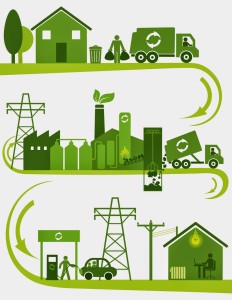Today, as the effects of global climate change are being increasingly felt, notions such as sustainable development, stakeholder participation, corporate social responsibility, environmental impact, Global Reporting Standards and integrated reporting have begun to play an important part in the corporate strategies of not only international establishments but also those of Turkish companies. The most concrete proof for this is that 68 companies in Turkey are publishing regular sustainability reports today, in comparison to just a handful of companies in 2007…
An increasing number of entrepreneurs
Entrepreneurship has begun to attract serious attention in Turkey in recent years, as a factor that allows economies to grow dynamically and makes the greatest contribution to employment. The existence of global non-profits such as Endeavour, the increased importance attributed to entrepreneurship in educational institutions, the development and proximity of techno-parks, Small and Medium Enterprises Development Organisation (KOSGEB) and Scientific and Technological Research Council of Turkey (TÜBİTAK) funds and grants; angel investor incentives through the Angel Investment System (BKS) and the expansion of angel investor networks, the establishment of incubation centres and developments such as the “Special Stock Exchange” that was set up in November 2014 all continue to contribute to the creation of an entrepreneurship ecosystem in Turkey. All these newly introduced elements have a natural impact on the increased popularity of entrepreneurship in Turkey, as well as the increasing number of entrepreneurs in comparison to previous years.
The first definition of sustainable development, which was made in 1987, is as follows: “Sustainable development is development that meets the needs of the present without compromising the ability of future generations to meet their own needs.” This definition calls for long-term planning to replace the general tendency to make short- term plans. It requires that interests be structured not at the individual level but in such a manner so as to encompass the whole system. It asks the stakeholders to be a part of the decision-making process and to replace conflict with cooperation. The definition above also makes it a vital prerequisite to take into account what the social and environmental impact of any step to be taken might be. Furthermore in order for development to be sustainable there are two prime requirements: resource and energy saving, and innovation…
The following data contain the results of the examination of some sustainable development indices in Turkey: The cleantech innovation index which stands at 4.5 in developed countries ranges between 1.0 and 1.5 in Turkey.
In The World Energy Council Report 2012, Turkey ranks 84th in mitigating the environmental impact of energy production and it stands at number 62 among 94 countries in the energy sustainability index. The share of Turkey’s renewable energy resources in electricity production is 2 percent.
The level of carbon emission, which increased by 24 percent between 1990 and 2009, reached 422.4 million tons as of 2011. Carbon emission was reduced by 2 percent in 2012 compared to the previous year. It dropped by 1.1 percent in 2013 compared to the year before.
According to the 2015 data announced by the Turkish Statistical Institute the rate of unemployment rate stands at 10.4.
What is sustainable entrepreneurship?
 One of my favourite definitions of entrepreneurship is “An entrepreneur is one who can spot the difference between opportunities and threats, and can turn both into opportunities.” If we can treat the results of the above analyses and indices as opportunities rather than threats, we will see that there are many niche areas to fill and plenty of opportunities take in Turkey when it comes to sustainable entrepreneurship.
One of my favourite definitions of entrepreneurship is “An entrepreneur is one who can spot the difference between opportunities and threats, and can turn both into opportunities.” If we can treat the results of the above analyses and indices as opportunities rather than threats, we will see that there are many niche areas to fill and plenty of opportunities take in Turkey when it comes to sustainable entrepreneurship.
However at this point I must point out that although educational institutions, foundations, associations, private companies, public bodies and many other stakeholders are coming together to set up an entrepreneurship ecosystem due to the trust and belief in the added value that entrepreneurship creates in the economy, I cannot say that the same approach is being adopted when it comes to sustainability.
In fact such a need is what calls for a definition of sustainable entrepreneurship. Sustainable entrepreneurship starts off on the assumption that social, environmental and economic impact should co-exist in equilibrium. It encompasses a wide array of entrepreneurship types from non-profit social entrepreneurship that aims to create social transformation to ones that develop sustainable business practices. In short, these entrepreneurs strive to turn social and environmental problems into business opportunities to benefit the environment and society with added value. The key here is that such a process should take into account not only the interests of the entrepreneur but also that of the whole system, and that “money” should not be the only measuring instrument.
Competitors turn into stakeholders
How can sustainable entrepreneurship lead to gaining a sustainable competitive advantage? As Porter have stated, gaining advantage over competitors using attribute(s) that allow an organisation to outperform its competition constitutes the root of sustainable competitive advantage. Looking at the four strategies of differentiation, competitive advantage, innovation and operational efficiency that that are used to gain a competitive advantage, we should be able to assume that the strategy to be used in entrepreneurship should naturally be innovation. Today, at a time when concepts such as green supply-chain, clean production, industrial symbiosis, open innovation, sharing economy and non-profit social entrepreneurship are becoming increasingly important, we are witnessing that rivals are also becoming a part of the definition of stakeholders. This makes it compulsory that we adopt a broader perspective.
In light of all this, giving the following steps priority will prove beneficial to the creation of a sustainable entrepreneurship ecosystem:
- The meaning of “sustainable development” and the importance of social and environmental responsibility for future generations’ right to live must be explained and understood;
- Starting from a young age, the education system must teach and emphasise the fact that there are many other values that are way more important than money in a society and social awareness of social and environmental responsibilities must be created;
- NGOs, educational institutions, the state, private establishments and all other entrepreneurship-related organisations, and entrepreneurs must organise fact-finding conferences and ensure coordination with respect to sustainability;
- An infrastructure that will encourage establishments and entrepreneurships in particular to assume an active role in the implementation of the articles regarding human rights, environment, employee rights and anti-corruption, as mentioned in the UN Global Compact, must be set up;
- As part of item 4, efforts must be made to ensure the integration of entrepreneurship and sustainability in the 6 areas (supportive culture, efficient policies, financial resources, human power, appropriate market, corporate support and infrastructure facilities) that were put forward in the model for the creation of an entrepreneurship ecosystem.
I believe we will take the first steps towards a more sustainable future where the parties involved are stakeholders and the advantage to be gained will benefit all stakeholders, rather than one where the competitive advantage will be at the individual level.




No Comment